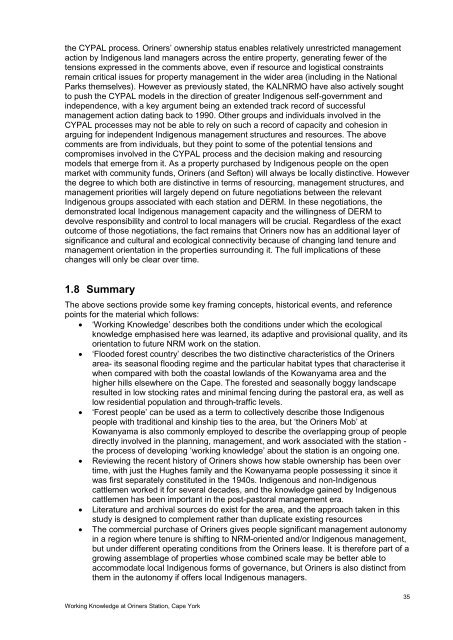WfHC - cover page (not to be used with pre-printed report ... - CSIRO
WfHC - cover page (not to be used with pre-printed report ... - CSIRO
WfHC - cover page (not to be used with pre-printed report ... - CSIRO
Create successful ePaper yourself
Turn your PDF publications into a flip-book with our unique Google optimized e-Paper software.
the CYPAL process. Oriners‟ ownership status enables relatively unrestricted management<br />
action by Indigenous land managers across the entire property, generating fewer of the<br />
tensions ex<strong>pre</strong>ssed in the comments above, even if resource and logistical constraints<br />
remain critical issues for property management in the wider area (including in the National<br />
Parks themselves). However as <strong>pre</strong>viously stated, the KALNRMO have also actively sought<br />
<strong>to</strong> push the CYPAL models in the direction of greater Indigenous self-government and<br />
independence, <strong>with</strong> a key argument <strong>be</strong>ing an extended track record of successful<br />
management action dating back <strong>to</strong> 1990. Other groups and individuals involved in the<br />
CYPAL processes may <strong>not</strong> <strong>be</strong> able <strong>to</strong> rely on such a record of capacity and cohesion in<br />
arguing for independent Indigenous management structures and resources. The above<br />
comments are from individuals, but they point <strong>to</strong> some of the potential tensions and<br />
compromises involved in the CYPAL process and the decision making and resourcing<br />
models that emerge from it. As a property purchased by Indigenous people on the open<br />
market <strong>with</strong> community funds, Oriners (and Sef<strong>to</strong>n) will always <strong>be</strong> locally distinctive. However<br />
the degree <strong>to</strong> which both are distinctive in terms of resourcing, management structures, and<br />
management priorities will largely depend on future negotiations <strong>be</strong>tween the relevant<br />
Indigenous groups associated <strong>with</strong> each station and DERM. In these negotiations, the<br />
demonstrated local Indigenous management capacity and the willingness of DERM <strong>to</strong><br />
devolve responsibility and control <strong>to</strong> local managers will <strong>be</strong> crucial. Regardless of the exact<br />
outcome of those negotiations, the fact remains that Oriners now has an additional layer of<br />
significance and cultural and ecological connectivity <strong>be</strong>cause of changing land tenure and<br />
management orientation in the properties surrounding it. The full implications of these<br />
changes will only <strong>be</strong> clear over time.<br />
1.8 Summary<br />
The above sections provide some key framing concepts, his<strong>to</strong>rical events, and reference<br />
points for the material which follows:<br />
„Working Knowledge‟ descri<strong>be</strong>s both the conditions under which the ecological<br />
knowledge emphasised here was learned, its adaptive and provisional quality, and its<br />
orientation <strong>to</strong> future NRM work on the station.<br />
„Flooded forest country‟ descri<strong>be</strong>s the two distinctive characteristics of the Oriners<br />
area- its seasonal flooding regime and the particular habitat types that characterise it<br />
when compared <strong>with</strong> both the coastal lowlands of the Kowanyama area and the<br />
higher hills elsewhere on the Cape. The forested and seasonally boggy landscape<br />
resulted in low s<strong>to</strong>cking rates and minimal fencing during the pas<strong>to</strong>ral era, as well as<br />
low residential population and through-traffic levels.<br />
„Forest people‟ can <strong>be</strong> <strong>used</strong> as a term <strong>to</strong> collectively descri<strong>be</strong> those Indigenous<br />
people <strong>with</strong> traditional and kinship ties <strong>to</strong> the area, but „the Oriners Mob‟ at<br />
Kowanyama is also commonly employed <strong>to</strong> descri<strong>be</strong> the overlapping group of people<br />
directly involved in the planning, management, and work associated <strong>with</strong> the station -<br />
the process of developing „working knowledge‟ about the station is an ongoing one.<br />
Reviewing the recent his<strong>to</strong>ry of Oriners shows how stable ownership has <strong>be</strong>en over<br />
time, <strong>with</strong> just the Hughes family and the Kowanyama people possessing it since it<br />
was first separately constituted in the 1940s. Indigenous and non-Indigenous<br />
cattlemen worked it for several decades, and the knowledge gained by Indigenous<br />
cattlemen has <strong>be</strong>en important in the post-pas<strong>to</strong>ral management era.<br />
Literature and archival sources do exist for the area, and the approach taken in this<br />
study is designed <strong>to</strong> complement rather than duplicate existing resources<br />
The commercial purchase of Oriners gives people significant management au<strong>to</strong>nomy<br />
in a region where tenure is shifting <strong>to</strong> NRM-oriented and/or Indigenous management,<br />
but under different operating conditions from the Oriners lease. It is therefore part of a<br />
growing assemblage of properties whose combined scale may <strong>be</strong> <strong>be</strong>tter able <strong>to</strong><br />
accommodate local Indigenous forms of governance, but Oriners is also distinct from<br />
them in the au<strong>to</strong>nomy if offers local Indigenous managers.<br />
Working Knowledge at Oriners Station, Cape York<br />
35
















